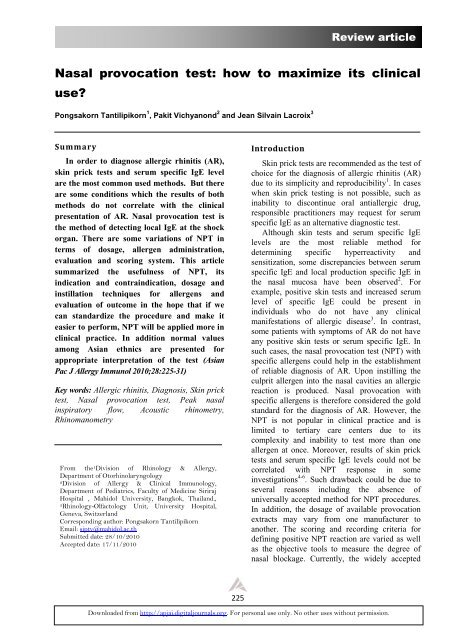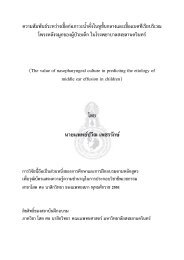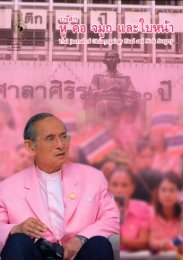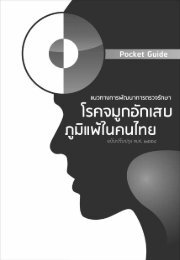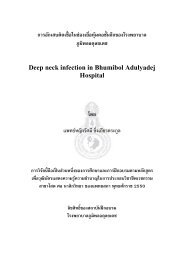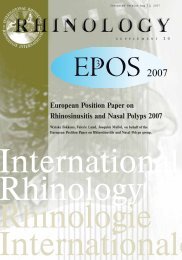Nasal provocation test: how to maximize its clinical use?
Nasal provocation test: how to maximize its clinical use?
Nasal provocation test: how to maximize its clinical use?
Create successful ePaper yourself
Turn your PDF publications into a flip-book with our unique Google optimized e-Paper software.
Review article<strong>Nasal</strong> <strong>provocation</strong> <strong>test</strong>: <strong>how</strong> <strong>to</strong> <strong>maximize</strong> <strong>its</strong> <strong>clinical</strong><strong>use</strong>?Pongsakorn Tantilipikorn 1 , Pakit Vichyanond 2 and Jean Silvain Lacroix 3SummaryIn order <strong>to</strong> diagnose allergic rhinitis (AR),skin prick <strong>test</strong>s and serum specific IgE levelare the most common <strong>use</strong>d methods. But thereare some conditions which the results of bothmethods do not correlate with the <strong>clinical</strong>presentation of AR. <strong>Nasal</strong> <strong>provocation</strong> <strong>test</strong> isthe method of detecting local IgE at the shockorgan. There are some variations of NPT interms of dosage, allergen administration,evaluation and scoring system. This articlesummarized the <strong>use</strong>fulness of NPT, <strong>its</strong>indication and contraindication, dosage andinstillation techniques for allergens andevaluation of outcome in the hope that if wecan standardize the procedure and make iteasier <strong>to</strong> perform, NPT will be applied more in<strong>clinical</strong> practice. In addition normal valuesamong Asian ethnics are presented forappropriate interpretation of the <strong>test</strong> (AsianPac J Allergy Immunol 2010;28:225-31)Key words: Allergic rhinitis, Diagnosis, Skin prick<strong>test</strong>, <strong>Nasal</strong> <strong>provocation</strong> <strong>test</strong>, Peak nasalinspira<strong>to</strong>ry flow, Acoustic rhinometry,RhinomanometryFrom the 1 Division of Rhinology & Allergy,Department of O<strong>to</strong>rhinolaryngology2Division of Allergy & Clinical Immunology,Department of Pediatrics, Faculty of Medicine SirirajHospital , Mahidol University, Bangkok, Thailand.,3Rhinology-Olfac<strong>to</strong>logy Unit, University Hospital,Geneva, SwitzerlandCorresponding author: Pongsakorn TantilipikornEmail: siptv@mahidol.ac.thSubmitted date: 28/10/2010Accepted date: 17/11/2010IntroductionSkin prick <strong>test</strong>s are recommended as the <strong>test</strong> ofchoice for the diagnosis of allergic rhinitis (AR)due <strong>to</strong> <strong>its</strong> simplicity and reproducibility 1 . In caseswhen skin prick <strong>test</strong>ing is not possible, such asinability <strong>to</strong> discontinue oral antiallergic drug,responsible practitioners may request for serumspecific IgE as an alternative diagnostic <strong>test</strong>.Although skin <strong>test</strong>s and serum specific IgElevels are the most reliable method fordetermining specific hyperreactivity andsensitization, some discrepancies between serumspecific IgE and local production specific IgE inthe nasal mucosa have been observed 2 . Forexample, positive skin <strong>test</strong>s and increased serumlevel of specific IgE could be present inindividuals who do not have any <strong>clinical</strong>manifestations of allergic disease 3 . In contrast,some patients with symp<strong>to</strong>ms of AR do not haveany positive skin <strong>test</strong>s or serum specific IgE. Insuch cases, the nasal <strong>provocation</strong> <strong>test</strong> (NPT) withspecific allergens could help in the establishmen<strong>to</strong>f reliable diagnosis of AR. Upon instilling theculprit allergen in<strong>to</strong> the nasal cavities an allergicreaction is produced. <strong>Nasal</strong> <strong>provocation</strong> withspecific allergens is therefore considered the goldstandard for the diagnosis of AR. However, theNPT is not popular in <strong>clinical</strong> practice and islimited <strong>to</strong> tertiary care centers due <strong>to</strong> <strong>its</strong>complexity and inability <strong>to</strong> <strong>test</strong> more than oneallergen at once. Moreover, results of skin prick<strong>test</strong>s and serum specific IgE levels could not becorrelated with NPT response in someinvestigations 4-6 . Such drawback could be due <strong>to</strong>several reasons including the absence ofuniversally accepted method for NPT procedures.In addition, the dosage of available <strong>provocation</strong>extracts may vary from one manufacturer <strong>to</strong>another. The scoring and recording criteria fordefining positive NPT reaction are varied as wellas the objective <strong>to</strong>ols <strong>to</strong> measure the degree ofnasal blockage. Currently, the widely accepted225Downloaded from http://apjai.digitaljournals.org. For personal <strong>use</strong> only. No other <strong>use</strong>s without permission.
Asian Pac J Allergy Immunol 2010;28:225-31criteria and techniques are adapted from EuropeanResearch Centers 7 .This article summarized the <strong>use</strong>fulness ofNPT, <strong>its</strong> indication and contraindication, dosageand instillation techniques for allergens andevaluation of outcome in the hope that if we canstandardize the procedure and make it easier <strong>to</strong>perform, NPT will be applied more in <strong>clinical</strong>practice. In addition normal values among Asianethnics are presented for appropriate interpretationof the <strong>test</strong>.Application of NPT and <strong>its</strong> importanceSkin Prick <strong>test</strong>ing (SPT) is a standard <strong>test</strong>ingfor allergy diagnosis. Patients with larger whealsizes from SPT are the ones with higher <strong>clinical</strong>correlation than those with smaller wheal sizes.Some patients with negative SPTs but withpositive intradermal <strong>test</strong>s (IDT) do not react <strong>to</strong>allergen challenge. However, this has recentlybeen questioned by reports from Bodtger in 2006and Scadding in 2007. These authors reported thatpatients with ab definate allergic his<strong>to</strong>ry but withnegative skin <strong>test</strong>s could later become developboth positive skin <strong>test</strong> and NPT results 8,9 . Suchpatients with convincing allergic his<strong>to</strong>ry couldmake it difficult for clinicians <strong>to</strong> make a correctdiagnosis during their first encounter with thepatient. When there is doubt regarding thediagnosis of nasal allergy, NPT could be a <strong>use</strong>fulprocedure for such patients 10,11 . Moreover, thosewith multiple sensitivities, i.e., those who react <strong>to</strong>several allergens by skin <strong>test</strong>ings, should becandidates for NPT in order <strong>to</strong> identify the culpritallergens. Thus, such patients could be improvedthrough environmental control measures and thephysician could select appropriate allergens forallergen immunotherapy.To date, the indications of NPT are:1. To confirm the diagnosis of allergicrhinitis in patients with negative allergy skin <strong>test</strong>sor without serum specific IgE.2. To confirm the <strong>clinical</strong> relevance of aspecific airborn allergen in patients with multiplesensitivities, as determined by skin <strong>test</strong>ings 12 .3. To confirm nasal reactivity <strong>to</strong> specificallergen before initiating immunotherapy 13 .4. To assess the hyper-reactive state of nonallergicrhinitis, using capsaicin- orlipopolysaccharide (LPS)- challenge 14 .5. To confirm the role of a specific allergenin patients with bronchial asthma in whichbronchial <strong>provocation</strong> <strong>test</strong> could not be safelyperformed 7 .6. To confirm the role of a specificoccupational agent 15,16 .7. To study patho-physiology of allergicand non allergic reactions.8. For allergy research such as theidentification of new allergens or in the processof evaluating new treatments for allergicconditions.Nevertheless, NPT is still not <strong>use</strong>d as often as itcould be in <strong>clinical</strong> practice.NPT can be carried out safely with only a fewminor side effects. In order <strong>to</strong> avoid side effects,NPT should not be performed during anexacerbation of the allergic condition or inpatients with a his<strong>to</strong>ry of severe systemicreactions (anaphylactic shock) <strong>to</strong> the particularallergen of interest.To minimize false positive results, NPT shouldbe avoided during an acute episode of rhinitissince the increase vascular permeability and nasalhyper-reactivity could alter the results 17 .To minimize false negative results, certainmedications should be discontinued prior <strong>to</strong> NPT.These are listed in Table 1.Principle of NPTAn allergen extract or other provocative agents isinstilled intranasally and the intensity of nasalsymp<strong>to</strong>ms such as itching, sneezing, rhinorrheaand nasal obstruction occurred are recorded.Distant symp<strong>to</strong>ms, such as ocular and bronchial,can be observed as well. The most importan<strong>to</strong>utcome parameter is nasal obstruction which canbe assessed by various methods such as peaknasal inspira<strong>to</strong>ry flow (PNIF), rhinomanometry(RMM) or acoustic rhinometry (ARM) 19,20 .Table 1. Medications should be s<strong>to</strong>ppedbefore nasal <strong>provocation</strong> <strong>test</strong>.MedicationsDuration <strong>to</strong> s<strong>to</strong>p before nasal<strong>provocation</strong> <strong>test</strong>Oral antihistamine3 daysIntranasal corticosteroid 1 week 7 <strong>to</strong> 6 weeks 18Oral corticosteroid (greater than2 weeks10 mg/day)Topical nasal decongestant1 dayAntihypertensive (ACE inhibi<strong>to</strong>rs)3 weeks226Downloaded from http://apjai.digitaljournals.org. For personal <strong>use</strong> only. No other <strong>use</strong>s without permission.
<strong>Nasal</strong> <strong>provocation</strong> <strong>test</strong>Figure 1.<strong>Nasal</strong> <strong>provocation</strong> <strong>test</strong> and <strong>its</strong> response. SP = substance P, CGRP = Calci<strong>to</strong>nin-gene relatedpeptide, Ach = Acetylcholine, VIP = Vasoactive in<strong>test</strong>inal peptide, NO = Nitric oxide, LT = Leukotriene.Regarding the immediate allergic response, thereactions observed in the ipsilateral nostril areincreased nasal secretions (rhinorrhea), nasalblockage, and itching. Rhinorrhea and nasalobstruction are the main symp<strong>to</strong>ms occurring onthe contralateral side. This nasonasal reflexinvolves ipsilateral activation of sensory nervesand a bilateral parasympathetic reflex which canbe reduced by atropine-like drugs 18,21,22 .Technique<strong>Nasal</strong> endoscopy and patient preparationIntranasal examination with an endoscope isthe first necessary step <strong>to</strong> evaluate the pre-existingcondition or pathology within the nose. Someconditions, such as nasal septal deviation, nasalpolyp or atrophic rhinitis, could influence thenasal patency assessment before and after NPT.Patients, who have had recent surgery <strong>to</strong> the nose,should have NPT postponed for at least 8 weeks.To minimize the influence of nasal cycle orirritation in daily life, NPT should be performed atthe same time, i.e., in the morning and at least 30minutes after patients arrival, in order <strong>to</strong> beadapted <strong>to</strong> the temperature in the labora<strong>to</strong>ry.Allergen administrationBefore challenging the nose by allergenextract, both nasal cavities should be examined <strong>to</strong>identify nonspecific ana<strong>to</strong>mical variations of nasalpatency ca<strong>use</strong>d by the nasal cycle 23 . Nonspecificnasal hyper-reactivity can also be investigated bychallenging the nasal mucosa with iso<strong>to</strong>nic salinesprayed in<strong>to</strong> the wider side of the nose 7 . Thisshould be done as a baseline challenge.Allergens are available in various forms suchas solution, powder or pollen grains. Suchallergen can be administered in<strong>to</strong> the nasal cavityby several methods i.e. pump spray, paper disc,a<strong>to</strong>mizer, pipettes, or dropper. Important issueswhich have <strong>to</strong> be considered before deliveringallergen are adverse effects, ease of instillation,amount of solution per delivery and distributionof mast cell in the nose. NPT can be performedunilaterally or bilaterally depending on themethod of allergen administration. Unilateralchallenge may be easier but bilateral challengeshould give higher number of positive reactions.According <strong>to</strong> our current knowledge of nasalphysiology, unilateral challenge should alsoprovide relevant information regarding theintensity of the nasonasal reflex elicited in thecontralateral side of the nose 18,23 .Impregnated paper discs could be <strong>use</strong>d as ameans <strong>to</strong> introduce allergen in<strong>to</strong> the nose. Theycould be placed on particular sites, such as onanterior tip of the inferior turbinate or the anteriorpart of the middle meatus (agger nasi area).Okuda reported the grea<strong>test</strong> sensitivity in the227Downloaded from http://apjai.digitaljournals.org. For personal <strong>use</strong> only. No other <strong>use</strong>s without permission.
Asian Pac J Allergy Immunol 2010;28:225-31Figure 2. Intranasal areanasi and middle meatus.<strong>use</strong>d for <strong>provocation</strong> <strong>test</strong>ing , i.e., anterior end of inferior turbinate, aggeragger nasi area when compared <strong>to</strong> the inferiorturbinate or nasal septum 24 . However, due <strong>to</strong> theease of placing discs on the inferior turbinate, thismethod is recommended by the author. On theother hand, physicians unfamiliar with forcepshandling could make iatrogenic injury <strong>to</strong> theintranasal structures. Due <strong>to</strong> these shortcomings,some researchers prefer other delivery methods.Bottle droppers and micropipette methods areeasy <strong>to</strong> <strong>use</strong> delivery devices. Nonetheless, theymay have some disadvantages since the area inthe nose where the allergen has been applied isnot seen. Moreover, allergen could be aspiratedin<strong>to</strong> the larynx, inducing cough, laryngealirritation, edema or bronchospasm 18 .A better method of delivery could be by usinghand-operated nasal spray. With the spraymethod, a reasonable contact area would be <strong>to</strong> theanterior part of nasal cavities. Beca<strong>use</strong> of ease of<strong>use</strong> and the predictability of the amount ofallergen administered, most of research centers inEurope recommend this method as a standarddelivery system 23 . A<strong>to</strong>mizers also generate largerparticles which help avoiding aspiration ofallergens in<strong>to</strong> the lower airways.Allergen dosageSome investiga<strong>to</strong>rs <strong>use</strong> titration doses butsome <strong>use</strong> one single concentration of allergen forroutine <strong>clinical</strong> NPT 7 . For titration NPT, thelowest allergen concentration should be startedfrom 1:10,000 <strong>to</strong> 1:5,000 w/vol or 50 allergenunit (AU)/ml or 50-100 protein nitrogen unit(PNU) 7,25 . If the initial concentration does notinduce any symp<strong>to</strong>m or <strong>clinical</strong> signs, then thenext concentration is increased by a 3-foldincrement, e.g. 1:10,000, 1: 3,000, 1: 1,000 26 .It should be noted that such recommendeddoses have been applied <strong>to</strong> European subjects.According <strong>to</strong> a study by Roongapinun et al.performed in 44 Thai patients with perennialallergic rhinitis, significant changes in <strong>to</strong>tal nasalsymp<strong>to</strong>m score (TNSS) and nasal airwayresistance (NAR) were observed at theconcentration of500-1,000 AU/ml 27 .The dosage of allergen will also depend on thedelivery technique. For the paper disc technique,Okuda <strong>use</strong>d 3mm diameter disc soaked with 5-500 ug ho<strong>use</strong> dust extract 24 . Schumacher et al.<strong>use</strong>d 4 mm disc with 10 µl dose 28 . We havemodified the Okuda-paper disc method by using5mm disc with a 0.01 ml dose 29 . For the a<strong>to</strong>mizerdosimeter,0.1 ml of allergen per spray is <strong>use</strong>d.The <strong>test</strong> solution is applied in<strong>to</strong> the nose bypointing the device upwards and laterally <strong>to</strong>deposit allergen solution on the middle andinferior turbinates, while avoiding sprayingdirectly <strong>to</strong> the back of the nose 7 . EvaluationFour cardinal symp<strong>to</strong>ms of allergic rhinitis areassessed before and after instillation of allergenextract in<strong>to</strong> the nasal cavity. They are itching,sneezing, rhinorrhea and nasal obstruction.228Downloaded from http://apjai.digitaljournals.org. For personal <strong>use</strong> only. No other <strong>use</strong>s without permission.
Extranasal symp<strong>to</strong>ms such as coughing andophthalmic symp<strong>to</strong>ms are also recorded.Symp<strong>to</strong>ms are assessed subjectively by patientsusually using a 4 point rating scale. Objectiveevaluations such as weighing nasal secretion,measuring nasal airflow and/or nasal airwayresistance, or analysis of inflamma<strong>to</strong>ry media<strong>to</strong>rscould also be employed.Peak nasal inspira<strong>to</strong>ry flow (PNIF) is a simplemethod <strong>to</strong> assess nasal airflow (Clement Clark,Harlow, UK) . The normal value of PNIF among92 healthy Thai volunteers is 112.3 L/min. If thenasal airflow and nasal airway resistance (NAR)as measured by active anterior rhinomanometry(RMM) is <strong>use</strong>d, pressure difference at 150 Pa isrecommended as a reference pressure in Europe.However, in a study of Bunnag et al. including130 healthy Thais, 75 Pa was recommended as areference pressure difference since 13.79% ofThai subjects were not able <strong>to</strong> reach the pressuredifference recommended in Europe(150 Pa) 30 .<strong>Nasal</strong> patency can be assessed by acousticrhinometer (ARM) which provides a minimalcross-sectional area (MCA) of the nasal cavityand a calculated nasal volume (NV). Table 2 listsnormal values for minimal cross sectional areaand nasal volume among 135 healthy Thais 31 .Scoring systemNPT is considered positive if the nasal airflowdecreases by more than 40% of the baseline value,regardless of the <strong>clinical</strong> symp<strong>to</strong>m score. It is alsoconsidered positive if nasal airflow decreases bygreater than 20% of the baseline value, combinedwith a symp<strong>to</strong>m score greater than 3 32 (Table 3).Another scoring system considers a change ofNAR of 100% from baseline as a cut-off value 33 .Recently, the study of Chusakul et al. compared<strong>Nasal</strong> <strong>provocation</strong> <strong>test</strong>Table 2. Mean value of minimal cross sectionalarea (MCA) and nasal volume (NV) by acousticrhinometer (ARM) in 135 healthy Thais 31 .BeforeAfter DecongestantionDecongestantionMCA (cm2) 0.61 +/- 0.6 0.64 +/- 0.1NV (cm3) 3.66 +/- 0.6 4.18 +/- 0.7the cu<strong>to</strong>ff value of symp<strong>to</strong>m scores by visualanalog scale (VAS) and PNIF after NPT <strong>to</strong> ho<strong>use</strong>dust mite extract. They demonstrated the superiordiagnostic value of VAS change when comparedwith the change in PNIF 34 .Research applications of NPTThe outcome measurements fo NPT, asmentioned earlier, focus on the immediate allergicresponse, characterized by itching, sneezing,rhinorrhea and nasal blockage which is enable theinvestiga<strong>to</strong>r <strong>to</strong> identify the causative allergen(s).However, cellular inflammation, cy<strong>to</strong>kines andneuro-hormones in the nasal secretions from thelate phase nasal allergic reaction can also bestudied 35,36 . Therefore, NPT can also be <strong>use</strong>d <strong>to</strong>elucidate the patho-physiological mechanism ofAR. Cellular changes after NPT can be assessedby nasal smear or scraping methods. <strong>Nasal</strong>secretions produced after NPT can be collected byblowing or nasal lavage techniques and furtheranalyzed for plasma proteins, media<strong>to</strong>rs andcy<strong>to</strong>kines.Clinical applications of NPTNPT for diagnosis of AR or for determiningthe hyper-reactivity status of non-specific rhinitisis still much under<strong>use</strong>d in <strong>clinical</strong> practicebeca<strong>use</strong> of the time-consuming nature of theTable 3. Scoring system of nasal <strong>provocation</strong><strong>test</strong>ing 32Symp<strong>to</strong>m Severity ScoreRhinorrhea (judged by examiner) No secretion 0Slightly increase 1Prof<strong>use</strong> 2Sneezing 0-2 sneezes 03-5 sneezes 1More than 5 sneezes 2Extranasal symp<strong>to</strong>ms None 0Watery eyes 1Cough or urticaria 2Figure 3. Peak nasal inspira<strong>to</strong>ry flowmeasurement (PNIF). (Picture <strong>use</strong>d withsubjected permission).229Downloaded from http://apjai.digitaljournals.org. For personal <strong>use</strong> only. No other <strong>use</strong>s without permission.
Asian Pac J Allergy Immunol 2010;28:225-31Figure 4. Bar graphs s<strong>how</strong> mean value of peaknasal inspira<strong>to</strong>ry flow (PNIF) before and afterdecongestion.procedure and complexity of the methods forobjective nasal airway assessment. From theabove review, we think that the method of NPTcould be simplified for easy <strong>use</strong> in <strong>clinical</strong>practice as follows: Administration by nasal spray with 0.125-0.15 ml per puff Challenge both sides of the nose Single dose challenge is preferred i.e. 50or 100 AU of allergen extract Scoring system according <strong>to</strong> Table 3 andassess nasal airflow by PNIF change 20-40%ConclusionsNPT is a <strong>use</strong>ful method in diagnosis of allergicdiseases and in determining the hyper-reactivestatus in non-specific rhinitis. Its indications,contraindications, technique, outcome measuresand criteria for positive <strong>test</strong> results are reviewed.There are variations in challenge dosages,methods of allergen application, outcomemeasurements and criteria for a positive <strong>test</strong> andthe normal values among different population.Due <strong>to</strong> such differences, it is currently difficult <strong>to</strong>compare results of NPT between different centers.For allergy research, there is an urgent need for aninternational consensus <strong>to</strong> overcome thesevariations in order <strong>to</strong> establish this <strong>test</strong> as a goldstandard. Such consensus should contribute <strong>to</strong>more <strong>use</strong> of NPT as a diagnostic <strong>to</strong>ol for chronicrhinitis. To <strong>maximize</strong> <strong>its</strong> <strong>use</strong> in <strong>clinical</strong> practice,the simplified method and the criteria suggestedby this article may make it easier <strong>to</strong> utilize fordiagnosis AR/NAR.AcknowledgementsThe authors would like <strong>to</strong> thank Professor Dr.Chaweewan Bunnag and Associate professor DrParaya Assanasen for their contribution inreviewing the manuscript.References1. Bousquet J, Khaltaev N, Cruz AA, Denburg J, Fokkens WJ, Togias A, etal. Allergic rhinitis and <strong>its</strong> impact on asthma (ARIA) 2008 update (incollaboration with the world health organization, GA(2)LEN andAllerGen). Allergy. 2008; 63: 8-160.2. Rondón C, Fernandez J, Can<strong>to</strong> G, Blanca M. Local allergic rhinitis:concept, <strong>clinical</strong> manifestations, and diagnostic approach. J InvestigAllergol Clin Immunol. 2010;20:364-713. Dreborg S, Frew A. Position paper: Allergen standardization and skin<strong>test</strong>s. The European Academy of allergology and Clinical Immunology.Allergy. 1993; 48: 48-82.4. Pelikan Z. The diagnostic approach <strong>to</strong> immediate hypersensitivity inpatients with allergic rhinitis: a comparison of nasal challenges andserum RAST. Ann Allergy. 1983; 51: 395-400.5. Deuschl H, Johansson SG. Specific IgE antibodies in nasal secretionfrom patients with allergic rhinitis and with negative or weakly positiveRAST on the serum. Clin Allergy. 1977; 7: 195-202.6. Niggemann B, Kleinau I, Schou C, Hansen GN, Wahn U, et al.Discrepancies between in vitro and in vivo <strong>test</strong> for ho<strong>use</strong> dust miteallergy: is domestic exposure a better predic<strong>to</strong>r than sensitization? ClinExp Allergy. 1994; 24: 946-8.7. Gosepath J, Amedee RG, Mann WJ. <strong>Nasal</strong> <strong>provocation</strong> <strong>test</strong>ing as aninternational standard for evaluation of allergic and nonallergic rhinitis.Laryngoscope. 2005; 115: 512-6.8. Bodtger U, Poulsen LK, Linneberg A. Rhinitis symp<strong>to</strong>ms and IgEsensitization as risk fac<strong>to</strong>rs for development of later allergic rhinitis inadults. Allergy. 2006; 61: 712-6.9. Scadding GK. Further marches: allergic and nonallergic. Clin ExpAllergy. 2007; 37: 485-7.10. Druce HM, Schumacher MJ. <strong>Nasal</strong> <strong>provocation</strong> challenge. TheCommittee on Upper Airway Allergy. J Allergy Clin Immunol. 1990;86; 261-4.11. Melillo G, Bonini S, Cocco G, Davies RJ, de Monchy JG, Frolund L, etal. EAACI <strong>provocation</strong> <strong>test</strong>s with allegens. Report prepared by theEuropean Academy of Allergology and Clinical ImmunologySubcommittee on <strong>provocation</strong> <strong>test</strong> with allergens. Allergy. 1997; 52: 1-35.12. Lavasa S, Kumar L, Kaushal SC, Ganguli NK. Wheat threshing dust – a“new allergen” in April-May nasobronchial allergy. Indian Pediatr.1996; 33: 566-70.13. Passalacqua G, Albano M, Pronza<strong>to</strong> C, Riccio AM, Scordamaglia A,Falagiani P, et al. Long-term follow-up of nasal immunotherapy <strong>to</strong>Parietaria: <strong>clinical</strong> and local immunological effects. Clin Exp Allergy.1997; 27: 904-8.14. Sanico AM, Philip G, Proud D, Naclerio RM, Togias A. Comparison ofnasal mucosal responsiveness <strong>to</strong> neuronal stimulation in non-allergic andallergic rhinitis: effects of capsaicin nasal challenge. Clin Exp Allergy.1998; 28: 92-100.15. Hy<strong>to</strong>nen M, Sala E. <strong>Nasal</strong> <strong>provocation</strong> <strong>test</strong> in the diagnosis ofoccupational allergic rhinitis. Rhinology. 1996; 34: 86-90.16. Gorski P, Krakowiak A, Pazdrak K, Palczynski C, Ruta U, Walusiak J.<strong>Nasal</strong> challenge <strong>test</strong> in the diagnosis of allergic respira<strong>to</strong>ry diseases insubjects occupationally exposed <strong>to</strong> a high molecular allergen (flour).Occup Med (Lond). 1998;48:91-7.17. Connell JT. Quantitative intranasal pollen challenge. 3. The primingeffect in allergic rhinitis. J Allergy. 1969; 43: 33-44.18. Litvyakova LI, Baraniuk JN. Human nasal allergen <strong>provocation</strong> fordetermination of true allergic rhinitis: methods for clinicians. CurrAllergy Asthma Rep. 2002; 2:194-202.19. Fokkens W, Lund V, Mullol J; European Position Paper onRhinosinusitis and <strong>Nasal</strong> Polyps group. European position paper onrhinosinusitis and nasal polyps. Rhinol Suppl. 2007;20:1-136.20. Mygind N, Lowenstein H. Allergy and other environmental fac<strong>to</strong>rs. In :Proc<strong>to</strong>r DF , Andersen I, edi<strong>to</strong>rs. The nose. Upper airway physiology230Downloaded from http://apjai.digitaljournals.org. For personal <strong>use</strong> only. No other <strong>use</strong>s without permission.
<strong>Nasal</strong> <strong>provocation</strong> <strong>test</strong>and the atmospheric environment. Amsterdam: Elsevier BiomedicalPress; 1982. p. 377-97.21. Stjarne P, Lundblad L, Anggard A, Hokfelt T, Lundberg JM.Tachykinins and calci<strong>to</strong>nin gene-related peptide: co-existence in sensorynerves of the nasal mucosa and effects on blood flow. Cell Tissue Res.1989;256:439-46.22. Lacroix JS, Potter EK. Nasonasal reflex mechanisms in anaesthetizeddogs. Acta O<strong>to</strong>laryngol (S<strong>to</strong>ckh). 1999;119:249-56.23. Bachert C. <strong>Nasal</strong> <strong>provocation</strong> <strong>test</strong>: critical evaluation. In: Ring J,Behrendt HD, edi<strong>to</strong>rs. New Trends in Allergy IV. Berlin: Springer-Verlag; 1997. p.277-80.24. Okuda M. Basic study of nasal provocative <strong>test</strong>. First report: Side, site ofthe nose, size of site and allergen amount. Arch O<strong>to</strong> Rhino Laryngol.1977;214:241-6.25. Riechelmann H, Mewes T, Weschta M, Gropper G. <strong>Nasal</strong> allergen<strong>provocation</strong> with Derma<strong>to</strong>phagoides pteronyssinus in patients withchronic rhinitis referred <strong>to</strong> a rhinologic surgical center. Ann AllergyAsthma Immunol. 2002; 88: 624-31.26. Solomon WR. <strong>Nasal</strong> <strong>provocation</strong> <strong>test</strong>ing. In: Spec<strong>to</strong>r SL, edi<strong>to</strong>r.Provocation Testing in Clinical Practice. New York: M. Dekker; 1995.p. 647-92.27. Roongapinun S, Kraiwapan N, Fooanant S. An analysis of nasalresponses after ho<strong>use</strong> dust mites challenge in perennial allergic rhinitis.Chiang Mai Med Bull. 2005;44:137-45.28. Schumacher MJ, Pain MC. <strong>Nasal</strong> challenge <strong>test</strong>ing in grass pollen hayfever. J Allergy Clin Immunol. 1979;64:202-8.29. Bunnag C, Jareoncharsri P. <strong>Nasal</strong> Challenge Test. In: Vichyanond P,Pothikamjorn S, Ruxrungtham K, edi<strong>to</strong>rs. Allergy 2000’s. Bangkok:Chuanpim publishing; 1998. p. 327-30.30. Bunnag C, Jareoncharsri, Dachpunpour P, Vitavasiri A. <strong>Nasal</strong> airwayresistance in asymp<strong>to</strong>matic Thai population. Siriraj Hosp Gaz.1995;47:721-5.31. Tantilipikorn P, Jareoncharsri P, Voraprayoon S, Bunnag C, ClementPA. Acoustic rhinometry of asian noses. Am J Rhinol. 2008;22:617-20.32. Meltzer E, Schatz M, Zeiger R. Alleric and nonallergic rhinitis. In:Middle<strong>to</strong>n E, edi<strong>to</strong>r. Middle<strong>to</strong>n’s Allergy Principles and Practice. 4 th ed.St.Louis: Mosby; 1993. p. 1253-88.33. Pas<strong>to</strong>rello EA, Riario-Sforza GG, Incorvaia C, Segala M, Fumagalli M,Gandini R. Comparison of rhinomanometry, symp<strong>to</strong>m score andinflamma<strong>to</strong>ry cell counts in assessing the nasal late phase reaction <strong>to</strong>allergen challenge. J Allergy Clin Immunol. 1994; 93:85-92.34. Chusakul S, Phannaso C, Sangsarsri S, Aeumjaturapat S, Snidvongs K.Ho<strong>use</strong>-dust mite nasal <strong>provocation</strong>: A diagnostic <strong>to</strong>ol in perennialrhinitis. Am J Rhinol Allergy. 2010; 24:133-6.35. Baraniuk JN. Mechanism of allergic rhinitis. Curr Allergy Ashtma Rep.2001;1:207-17.36. Chris<strong>to</strong>doulopoulos P, Cameron L, Durham S, Hamid Q. Molecularpathology of allergic disease. II: Upper airway disease. J Allergy ClinImmunol. 2000;105:211-23.231Downloaded from http://apjai.digitaljournals.org. For personal <strong>use</strong> only. No other <strong>use</strong>s without permission.


